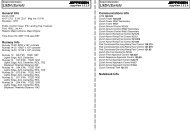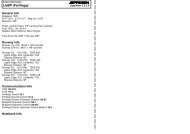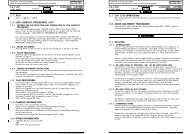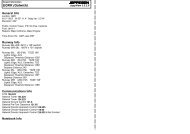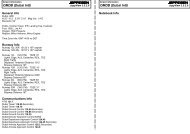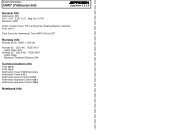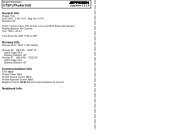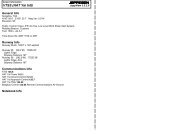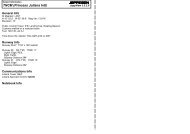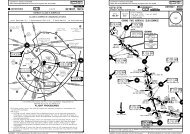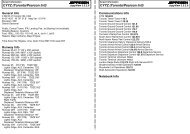EHAM (Schiphol) EHAM (Schiphol)
EHAM (Schiphol) EHAM (Schiphol)
EHAM (Schiphol) EHAM (Schiphol)
You also want an ePaper? Increase the reach of your titles
YUMPU automatically turns print PDFs into web optimized ePapers that Google loves.
Licensed to max. Printed on 16 Feb 2008.<br />
NOTICE: PRINTED FROM AN EXPIRED REVISION. Disc 01-2008<br />
<strong>EHAM</strong>/AMS<br />
SCHIPHOL<br />
+JEPPESEN<br />
19 OCT 07 10-1P5 Eff.25.Oct<br />
JEPPESEN<br />
JeppView 3.5.2.0<br />
AMSTERDAM, NETHERLANDS<br />
AIRPORT.BRIEFING<br />
2. ARRIVAL<br />
2.1.4.2. DURING DAY<br />
Navigation in the initial and intermediate approach segment is primarily based on<br />
radar vectors by ATC.<br />
The RNAV approaches (at ATC discretion) from<br />
LISDA for RWY 06 (11-1/11-1A),<br />
REGSU for RWY 18C (11-3/11-3A),<br />
POBAN for RWY 18R (11-4/11-4A),<br />
LOMKO for RWY 36C (11-8/11-8A) and<br />
MONUT for RWY 36R (11-9/11-9A),<br />
provide lateral guidance to intercept the ILS for the relevant RWY.<br />
Altitude and speed will be instructed by ATC.<br />
The example of ATC instruction 'Cleared for MONUT 1 Approach RWY 36R ' implies<br />
clearance to fly the published route including the ILS approach. The ILS GS must be<br />
intercepted from the last instructed altitude.<br />
2.1.4.3. NON-RNAV EQUIPPED ACFT<br />
Pilots shall inform ATC by use of the phrase "UNABLE (designator) TRANSITION (or<br />
APPROACH) DUE RNAV TYPE" if instructed to fly RNAV approach procedures.<br />
These ACFT will be guided by radar vectors or rerouted via conventional navigational<br />
aids.<br />
For NIGHT arrival operations with ACFT that are not equipped for TMA RNAV<br />
procedures, operators must hold a temporary exemption.<br />
2.1.5. TRANSFER TO SCHIPHOL TOWER<br />
While being transferred from SCHIPHOL Approach/Arrival to SCHIPHOL TOWER,<br />
initial contact shall consist of SCHIPHOL TOWER, CALLSIGN & RWY.<br />
2.2. SPEED RESTRICTIONS<br />
- For level and speed restrictions prior to SLPs refer to STARs.<br />
- MAX 250 KT over speed limit point SPL 30 DME (SLP1)<br />
- MAX 220 KT over speed limit point SPL 15 DME (SLP2).<br />
- ACFT with a cruising speed below the required speeds maintain cruising speed<br />
until the subsequent speed limit point.<br />
- After holding maintain speed 220 KT until further notice.<br />
- ATC will initiate speed reductions below 220 KT.<br />
- When established on ILS: maintain 160 KT until 4 NM before THR.<br />
- Speed greater than 220 KT accurate within 10 KT;<br />
Speed smaller than 220 KT accurate within 5 KT.<br />
Additionally, ATC may request specific speeds for accurate spacing.<br />
Comply with any level or speed adjustment as promptly as feasible within<br />
operational constraints.<br />
If level or speed change for ACFT performance reasons or weather conditions is<br />
necessary, advise ATC.<br />
2.3. NOISE ABATEMENT PROCEDURES<br />
2.3.1. GENERAL<br />
Between 2300-0600LT for RWY 06 and RWY 18R RNAV low-noise procedures for jet<br />
ACFT will be used, otherwise ACFT will be radar vectored towards interception of<br />
final leg at 3000'.<br />
Using a reduced flaps landing procedure is recommended. However, use of this<br />
procedure is subject to captain's decision and safety prevails at all times.<br />
- Intercept ILS (or for non-precision approaches follow a descent path after<br />
interception of final leg) using minimum flap settings with landing gear retracted<br />
which will NOT be lower than 5.2% (3^).<br />
- Select gear down after passing 2000'.<br />
- Postpone the selection of the minimum certified landing flap setting until passing<br />
1200'.<br />
ACFT executing a visual approach shall additionally intercept the final leg avoiding<br />
populated areas as much as possible.<br />
Licensed to max. Printed on 16 Feb 2008.<br />
NOTICE: PRINTED FROM AN EXPIRED REVISION. Disc 01-2008<br />
<strong>EHAM</strong>/AMS<br />
SCHIPHOL<br />
+ JEPPESEN<br />
21 SEP 07 10-1P6<br />
JEPPESEN<br />
JeppView 3.5.2.0<br />
AMSTERDAM, NETHERLANDS<br />
AIRPORT.BRIEFING<br />
2. ARRIVAL<br />
2.3.2. USE OF RWYS<br />
The most frequently used RWYs are 06, 18R, 36R, 18C, 36C & 27.<br />
Outside peak hours and during the NIGHT period a combination of 1 departure RWY<br />
and 1 landing RWY will be assigned. During outbound peak hours a combination of<br />
2 departure RWYs and 1 landing RWY may be in use. During inbound peak hours a<br />
combination of 1 departure RWY and 2 landing RWYs may be in use.<br />
RWYs 18L & 36L are not available for arrivals.<br />
From 2300-0600LT RWYs 04/22, 09/27, 18C, 24 and 36R are not available for<br />
arrivals.<br />
Deviations from the restrictions for arrivals on RWYs 18C 18L/36R, 09/27 and 24<br />
shall be made if no other RWY is available or usable or for rescue or relief<br />
operations.<br />
Assignment of RWYs in use is based on the Preferential RWY System.<br />
Propeller driven ACFT may be assigned a different take-off and landing RWY.<br />
The attention of pilots on final of RWY 04 or 22 is drawn to the size and texture of<br />
the parallel TWY which, under certain weather conditions, is more conspicious than<br />
the RWY.<br />
2.3.3. REVERSE THRUST<br />
After landing reverse thrust above idle shall not be used between 2300-0700LT on all<br />
RWYs, safety permitting.<br />
2.4. CAT II/III OPERATIONS<br />
RWYs 06, 18C/R, 27, 36C are approved for CAT II/III operations, RWY 36R is<br />
approved for CAT II operations, special aircrew and ACFT certification required.<br />
2.5. RWY OPERATIONS<br />
2.5.1. REDUCING RWY OCCUPANCY TIMES (ROT)<br />
The expected RWY exit point to achieve minimum RWY occupancy should be<br />
nominated during the approach briefing. It is better, in terms of ROT, to aim for an<br />
exit which can be made, rather than to aim for an earlier one, just to miss it and<br />
then to roll slowly to the next.<br />
Upon landing pilots should exit the RWY without delay.<br />
Taxi speed is to be reached after having vacated the RWY clearance area.<br />
High speed turn offs have been designed for vacating speeds of 30 KT.<br />
Available RWY length and indicated ACFT types:<br />
RWY Exit<br />
TWY<br />
* Right angle<br />
LIGHT ACFT MEDIUM ACFT HEAVY ACFT<br />
avail RWY<br />
length<br />
Exit<br />
TWY<br />
avail RWY<br />
length<br />
Exit<br />
TWY<br />
06 S3 4921'/1500m S4 7054'/2150m S4<br />
S6<br />
S7*<br />
18C<br />
avail RWY<br />
length<br />
Total RWY<br />
length<br />
7054'/2150m 10,663'/3250m<br />
9022'/2750m<br />
10,171'/3100m<br />
W6 4593'/1400m W7 6398'/1950m W8 8202'/2500m 10,827'/3300m<br />
27 N2 3927'/1200m N3 5577'/1700m N4 7382'/2250m 11,319'/3450m<br />
36C<br />
W5* 4921'/1500m W3 6562'/2000m - - 9350'/2850m<br />
36R E1 4429'/1350m E2 6070'/1850m E4*<br />
E5*<br />
8038'/2450m<br />
8858'/2700m<br />
9268'/2825m<br />
The available RWY length is not equal to the common known Landing Distance<br />
Available (LDA). The LDA is based on a complete standstill of the ACFT at the end of<br />
the LDA.<br />
CHANGES: Speed restrictions.<br />
| JEPPESEN SANDERSON, INC., 2005, 2007. ALL RIGHTS RESERVED.<br />
CHANGES: None.<br />
| JEPPESEN SANDERSON, INC., 2005, 2007. ALL RIGHTS RESERVED.




